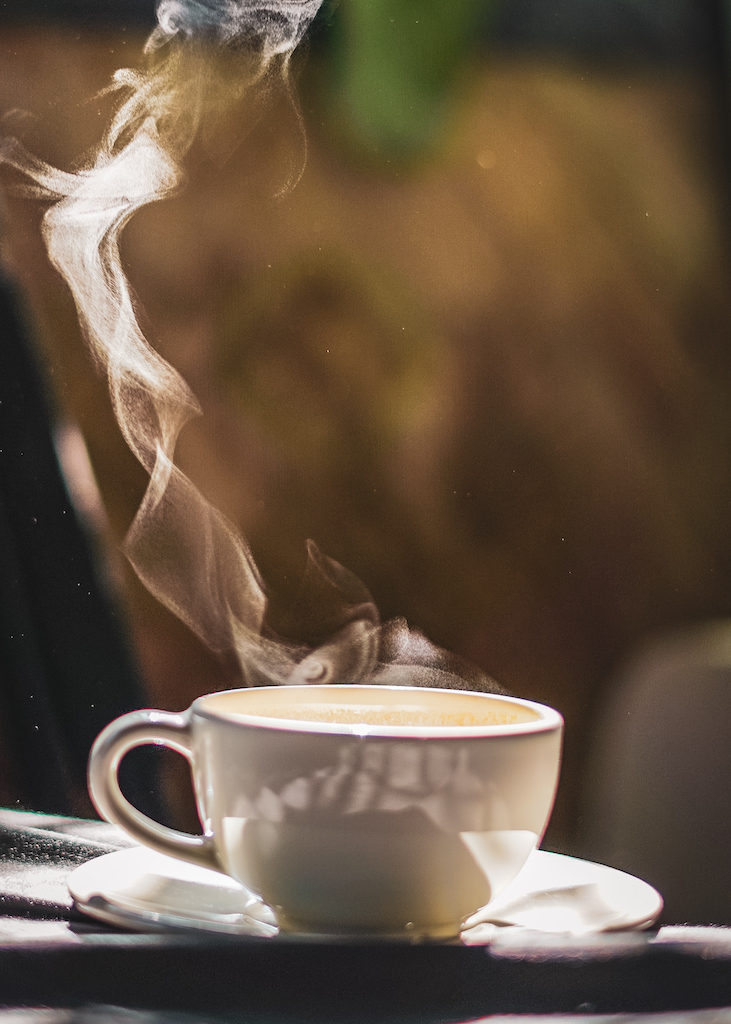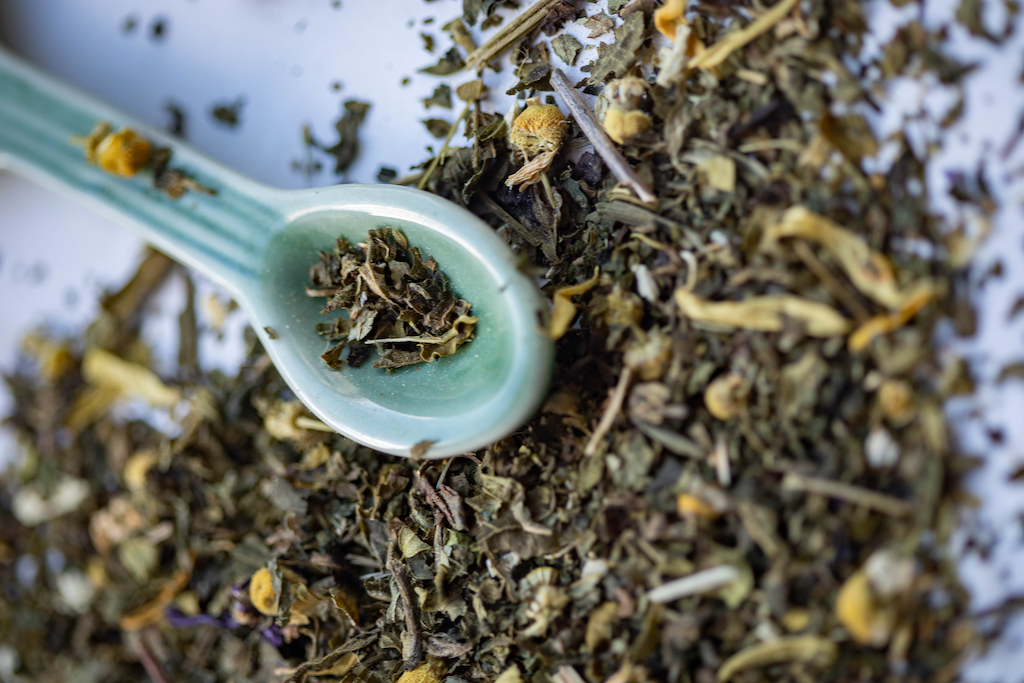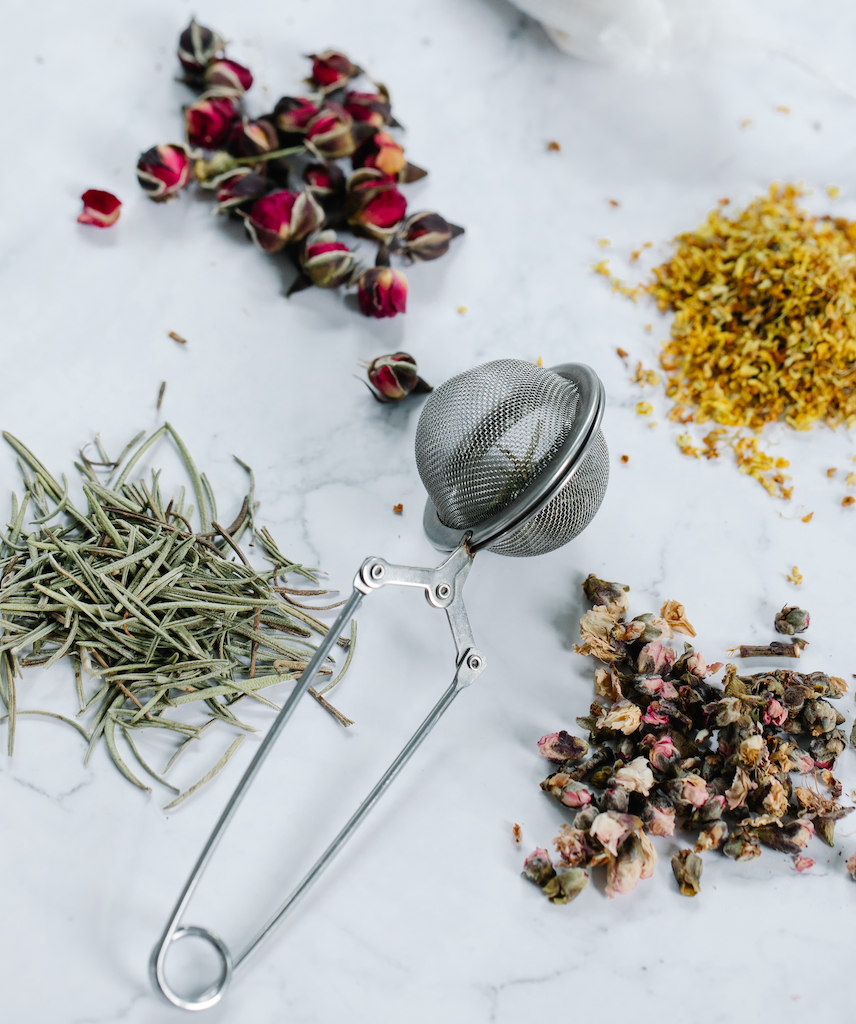
Herbal Tea is a welcome beverage in all weather. Chilled for a refreshing summer cooler, herbal tea is an optimal alternative to sugary beverages. In the Winter months, though, is when herbal tea really shines. It is warming, welcoming, healing and aromatic.
Herbal tea is versatile and adaptable. If you’ve only ever experienced herbal tea made from tea bags, you’re denying yourself a wonderful, exploratory experience. Once you have a few types of herbs on hand, there are any number of blends you can create. You can use fresh herbs growing around you, herbs you’ve harvested and dried yourself or dried herbs you’ve purchased from a reputable supplier.
If you read about herbal tea, you might have come across several terms that may be unfamiliar to you. We talk about making herbal tea using different methods. The main 2 methods of making herbal tea are infusions and decoctions.

Infusions
If you’ve ever poured boiled water over a tea bag in a mug, you’ve made an infusion. It’s that simple! We use the infusion method with the soft parts of the herb plant: leaves and flowers mostly. Infusion times vary depending on how strong you want the brew, if you’re using it simply for its aromatic pleasure or if you’re using the herbal brew for a specific ‘medicinal’ reason. Infuse most teas for as little as 5 or 10 minutes to extract the aromatic propertied of the herb. If you’re going for a more healing or prescriptive property of the herbs, 20 – 40 minutes is not too long to let the herbs steep. If you want to make a strong healing brew, leave the herbs steep overnight. We use cold water for steeping some herbs, like marshmallow, due to its mucilaginous nature.
Bring water to a boil, pour it over the herbs to steep either in a cup for one serving or in a teapot. Remove the herbs after the tea is the strength you desire, and if you like, add honey or another sweetener, milk to taste or just drink the infusion as is. It’s up to you and your taste. If you’re brewing a single serving of tea in a cup or mug, using a tea ball or other device to hold the herbs while brewing makes it easy to remove the leaves. If you’ve brewed a pot of tea with the leaves loose in the pot, pour the tea off the leaves through a strainer. I use a dedicated thermos to keep the tea hot after pouring it out of the pot where I brewed it.
Decoctions
A decoction of herbs is a brew that simmers in a pot over heat for a while- usually 20 – 30 minutes. Plant parts like roots, barks, seeds and other ‘hard’ parts of the plant are brewed in this manner. Keep a lid on the pot as you simmer the herbs so the water doesn’t evaporate. It doesn’t hurt to check the brew while it’s simmering if you’re planning to leave it for 30 or 40 minutes and add more water if some water has evaporated. Pour the tea off the herbs through a strainer and enjoy with or without sweetener or milk.
Choosing Your Tea
There are so many herbs to choose from when deciding what type of tea to make. If you want to have choice in flavors and properties of the tea, keep a few herbs on hand. Use the herbs alone or mix them into blends. You can add fresh or dried herbs to a brew that you make with a tea bag. Say you have tea bags of chamomile tea, but you’d like a little extra zing in your cup. Just add a teaspoon of dried peppermint or 2 teaspoons of fresh peppermint leaves to your cup when you pour the water over your tea bag. Remove the loose tea – or tea ball or other strainer- when you remove the tea bag.

Recipes
I have chosen the recipes below because they are all delicious and aid in your wellness journey. They contain easily sourced herbs. If you need to find dried herbs for your tea, The Herb Cottage has a selection here.
The Teas
I use “parts” when making tea blends. A “part” can be a teaspoon or a cupful depending on how much of the blend you want to make. You can use anything to measure your “part”, just make sure you use the same measurement for the whole recipe. I find with tea that has several ingredients, such as the ones listed here, it’s easiest to make a quantity so you don’t have to pull out all the bags and jars to make just a cup or a pot.
Cindy’s Wellness Tea
I created this blend to help me stay healthy and well during all seasons of the year. It is delicious hot on a cold day, but also chills well for a summertime tea.
- 6 parts dried Holy Basil, also called Tulsi
- 6 parts dried Jamaica, also called Roselle, hibiscus sabdariffa
- 2 parts dried Lemon Grass OR Lemon Balm
- 1 part dried Rose Petals
1 – 2 teaspoons tea blend for each 8 – 12 ounces water. Steep for 10 – 20 minutes. Honey is delicious in this, too.
Me Time Tea
We all need some ‘me time’, time to unwind. When we can disconnect from our devices and let our minds wander and relax. This tea blend is a wonderful companion for those moments.
- 2 parts dried Lemon Balm
- 1 part dried Chamomile Flowers
- 1 part dried Rose Petals
- ½ part dried Holy Basil, also called Tulsi
- Optional- 1 part dried Elder Flower OR Linden Flower
1 – 2 teaspoons tea blend for each 8 – 12 ounces water. Steep for 10 – 20 minutes. Honey is delicious in this, too.
Sweet Dreams Tea
Try this blend in the evening when you’re winding down from a busy day.
- 3 parts dried Chamomile Flower
- 2 parts dried Rose Petals
- 2 parts dried Holy Basil, also called Tulsi
- 1 Cinnamon Stick, broken up
1 – 2 teaspoons tea blend for each 8 – 12 ounces water. Steep for 10 – 20 minutes. Honey is delicious in this, too.
Immuno Support
This blend supports the immune system any time of year, but especially in the Winter months. The Licorice Root helps all the flavors blend and adds a natural sweetness.
- 1 part dried, powdered Licorice Root
- 2 part dried Holy Basil, also called Tulsi
- 2 part dried Marshmallow leaf
- 2 part dried Nettle Leaf
- 4 part dried Dandelion Leaf
1 – 2 teaspoons tea blend for each 8 -12 ounces of water. Steep 30 minutes. Add honey or other sweetener if desired.
Masala Chai
This blend is a bit more complex and uses some less than common herbs than the others in this post. I make it in a big batch and keep it in a jar so I can brew it at a moment’s notice. It is spicy, a little sweet, warming and satisfying.
- 0-15 small slices Astragalus Root, 12g
- 2 tablespoons (8g) Codonopsis Root
- 2 tablespoons dried, chopped Ginger Root OR 2 tablespoons Ginger Root Powder
- 2 tablespoons dried Rose Hips
- 2 tablespoons dried Orange Peel
- 1 tablespoon Cinnamon Chips OR 2 Cinnamon Sticks, broken up
- 1 teaspoon whole Peppercorns – I usually use Black Peppercorns
- 1/2 teaspoon hulled Cardamom, 24 g
- 1/4 teaspoon Cloves (about 3-5 cloves)
- 2 teaspoons Black Tea (optional)
- Optional- Echinacea, 4 tablespoons
- 1 quart water
Begin by combing all your herbs and spices together. Place the water in a medium-sized saucepan and bring to a boil. Add all of the spices to the pot except the tea and reduce to a slow simmer.
Simmer this spicy mix for 30-40 minutes and then strain.
If desired, add two teaspoons of Black Tea and let infuse for 3-5 minutes. Strain off the tea leaves. Add the rosewater to taste.
Add cream or milk to taste. Nut milks are delicious in this.
You can certainly add honey to this as well but I think you’ll be surprised how sweet it is already (the codonopsis root adds a lot of sweetness). Serve warm and enjoy!
I hope you’ll try some of these tea blends. The “recipes” are not meant to be written in stone. Please adapt them to your own taste.
Until Next Time,
Be well, enjoy your herbs and gardens. Cindy
Quote for the month:
When I despair, I remember that all through history, the way of truth and love has always won. There have been murderers and tyrants, and for a time they can seem invincible. But in the end they always fall. Think of it, always. -Mohandas Karamchand Gandhi (2 Oct 1869-1948)
